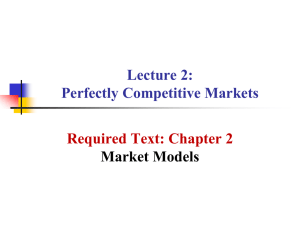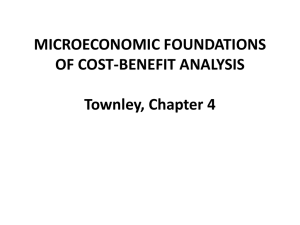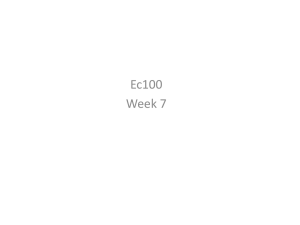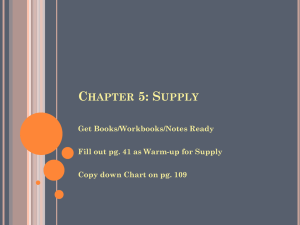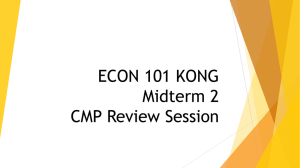pdyck08
advertisement
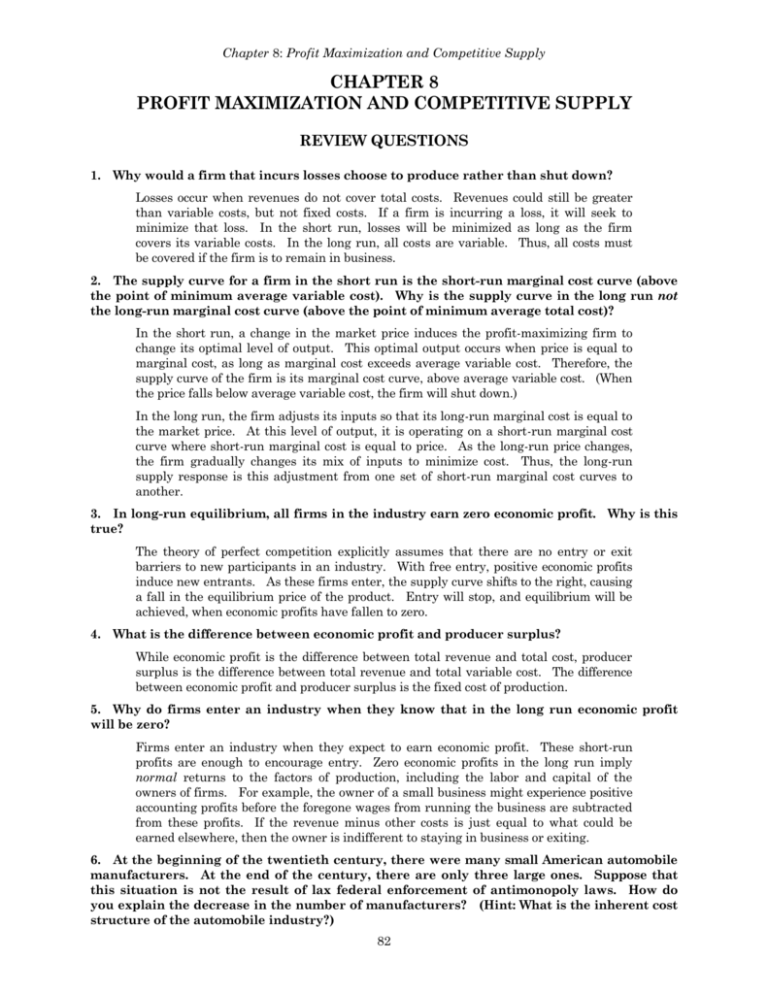
Chapter 8: Profit Maximization and Competitive Supply CHAPTER 8 PROFIT MAXIMIZATION AND COMPETITIVE SUPPLY REVIEW QUESTIONS 1. Why would a firm that incurs losses choose to produce rather than shut down? Losses occur when revenues do not cover total costs. Revenues could still be greater than variable costs, but not fixed costs. If a firm is incurring a loss, it will seek to minimize that loss. In the short run, losses will be minimized as long as the firm covers its variable costs. In the long run, all costs are variable. Thus, all costs must be covered if the firm is to remain in business. 2. The supply curve for a firm in the short run is the short-run marginal cost curve (above the point of minimum average variable cost). Why is the supply curve in the long run not the long-run marginal cost curve (above the point of minimum average total cost)? In the short run, a change in the market price induces the profit-maximizing firm to change its optimal level of output. This optimal output occurs when price is equal to marginal cost, as long as marginal cost exceeds average variable cost. Therefore, the supply curve of the firm is its marginal cost curve, above average variable cost. (When the price falls below average variable cost, the firm will shut down.) In the long run, the firm adjusts its inputs so that its long-run marginal cost is equal to the market price. At this level of output, it is operating on a short-run marginal cost curve where short-run marginal cost is equal to price. As the long-run price changes, the firm gradually changes its mix of inputs to minimize cost. Thus, the long-run supply response is this adjustment from one set of short-run marginal cost curves to another. 3. In long-run equilibrium, all firms in the industry earn zero economic profit. Why is this true? The theory of perfect competition explicitly assumes that there are no entry or exit barriers to new participants in an industry. With free entry, positive economic profits induce new entrants. As these firms enter, the supply curve shifts to the right, causing a fall in the equilibrium price of the product. Entry will stop, and equilibrium will be achieved, when economic profits have fallen to zero. 4. What is the difference between economic profit and producer surplus? While economic profit is the difference between total revenue and total cost, producer surplus is the difference between total revenue and total variable cost. The difference between economic profit and producer surplus is the fixed cost of production. 5. Why do firms enter an industry when they know that in the long run economic profit will be zero? Firms enter an industry when they expect to earn economic profit. These short-run profits are enough to encourage entry. Zero economic profits in the long run imply normal returns to the factors of production, including the labor and capital of the owners of firms. For example, the owner of a small business might experience positive accounting profits before the foregone wages from running the business are subtracted from these profits. If the revenue minus other costs is just equal to what could be earned elsewhere, then the owner is indifferent to staying in business or exiting. 6. At the beginning of the twentieth century, there were many small American automobile manufacturers. At the end of the century, there are only three large ones. Suppose that this situation is not the result of lax federal enforcement of antimonopoly laws. How do you explain the decrease in the number of manufacturers? (Hint: What is the inherent cost structure of the automobile industry?) 82 Chapter 8: Profit Maximization and Competitive Supply Automobile plants are highly capital-intensive. Assuming there have been no impediments to competition, increasing returns to scale can reduce the number of firms in the long run. As firms grow, their costs decrease with increasing returns to scale. Larger firms are able to sell their product for a lower price and push out smaller firms in the long run. Increasing returns may cease at some level of output, leaving more than one firm in the industry. 7. Industry X is characterized by perfect competition, so every firm in the industry is earning zero economic profit. If the product price falls, no firms can survive. Do you agree or disagree? Discuss. Disagree. As the market price falls, firms cut their production. If price falls below average total cost, firms continue to produce in the short run and cease production in the long run. If price falls below average variable costs, firms cease production in the short run. Therefore, with a small decrease in price, i.e., less than the difference between the price and average variable cost, firms can survive. With larger price decrease, i.e., greater than the difference between price and minimum average cost, no firms survive. 8. An increase in the demand for video films also increases the salaries of actors and actresses. Is the long-run supply curve for films likely to be horizontal or upward sloping? Explain. The long-run supply curve depends on the cost structure of the industry. If there is a fixed supply of actors and actresses, as more films are produced, higher salaries must be offered. Therefore, the industry experiences increasing costs. In an increasing-cost industry, the long-run supply curve is upward sloping. Thus, the supply curve for videos would be upward sloping. 9. True or false: A firm should always produce at an output at which long-run average cost is minimized. Explain. False. In the long run, under perfect competition, firms should produce where average costs are minimized. The long-run average cost curve is formed by determining the minimum cost at every level of output. In the short run, however, the firm might not be producing the optimal long-run output. Thus, if there are any fixed factors of production, the firm does not always produce where long-run average cost is minimized. 10. Can there be constant returns to scale in an industry with an upward-sloping supply curve? Explain. Constant returns to scale imply that proportional increases in all inputs yield the same proportional increase in output. Proportional increases in inputs can induce higher prices if the supply curves for these inputs are upward sloping. Therefore, constant returns to scale does not always imply long-run horizontal supply curves. 11. What assumptions are necessary for a market to be perfectly competitive? In light of what you have learned in this chapter, why is each of these assumptions important? The two primary assumptions of perfect competition are (1) all firms in the industry are price takers, and (2) there is free entry and exit of firms from the market. This chapter discusses how competitive equilibrium is achieved under these assumptions. In particular, we have seen that in a competitive equilibrium, price is equal to marginal cost. Both assumptions insure this equilibrium condition in the long run. In the short run, price could be greater than average cost, implying positive economic profits. With free entry and exit, positive economic profits would encourage other firms to enter. This entry exerts downward pressure on price until price is equal to both marginal cost and minimum average cost. 12. Suppose a competitive industry faces an increase in demand (i.e., the curve shifts upward). What are the steps by which a competitive market insures increased output? Does your answer change if the government imposes a price ceiling? 83 Chapter 8: Profit Maximization and Competitive Supply If demand increases with fixed supply, price and profits increase. The price increase induces the firms in the industry to increase output. Also, with positive profit, firms enter the industry, shifting the supply curve to the right. With an effective price ceiling, profit will be lower than without the ceiling, reducing the incentive for firms to enter the industry. With zero economic profit, no firms enter and there is no shift in the supply curve. 13. The government passes a law that allows a substantial subsidy for every acre of land used to grow tobacco. How does this program affect the long-run supply curve for tobacco? A subsidy to tobacco production decreases the firm’s costs of production. These cost decreases encourage other firms to enter tobacco production, and the supply curve for the industry shifts out. EXERCISES 1. From the data in Table 8.2, show what happens to the firm’s output choice and profit if the price of the product falls from $40 to $35. The table below shows the firm’s revenue and cost information when the price falls to $35. Q P TR P = 40 0 40 0 1 40 2 TC P = 40 MC P = 40 MR P = 40 TR P = 35 MR P = 35 P = 35 50 -50 ___ ___ 0 ___ -50 40 100 -60 50 40 35 35 -65 40 80 128 -48 28 40 70 35 -58 3 40 120 148 -28 20 40 105 35 -43 4 40 160 162 -2 14 40 140 35 -22 5 40 200 180 20 18 40 175 35 -5 6 40 240 200 40 20 40 210 35 10 7 40 280 222 58 22 40 245 35 23 8 40 320 260 60 38 40 280 35 20 9 40 360 305 55 45 40 315 35 10 10 40 400 360 40 55 40 350 35 -10 11 40 440 425 15 65 40 385 35 -40 At a price of $35, the firm should produce seven units to maximize profits, because this is the point closest to where price equals marginal cost without having marginal cost exceed price. 2. Again, from the data in Table 8.2, show what happens to the firm’s output choice and profit if the fixed cost of production increases from $50 to $100, and then to $150. What general conclusion can you reach about the effects of fixed costs on the firm’s output choice? 84 Chapter 8: Profit Maximization and Competitive Supply The table below shows the firm’s revenue and cost information for Fixed Cost, FC of 50, 100, and 150. Q P TR 0 40 0 1 40 2 TC FC = 50 FC = 50 MC TC FC = 100 FC = 100 TC FC = 150 FC = 150 50 -50 __ 100 -100 150 -120 40 100 -60 50 150 -110 200 -160 40 80 128 -48 28 178 -98 228 -148 3 40 120 148 -28 20 198 -78 248 -128 4 40 160 162 -2 14 212 -52 262 -102 5 40 200 180 20 18 230 -30 280 -80 6 40 240 200 40 20 250 -10 300 -60 7 40 280 222 58 22 272 8 322 -42 8 40 320 260 60 38 310 10 360 -40 9 40 360 305 55 45 355 5 405 -45 10 40 400 360 40 55 410 -10 460 -60 11 40 440 425 15 65 475 -35 525 -85 With fixed costs of 100, the firm maximizes profit at 8 units of output. It also minimizes losses with fixed costs of 150 at the same level. Fixed costs do not influence the optimal quantity, because they do not influence marginal cost. 3. Suppose you are the manager of a watchmaking firm operating in a competitive market. 2 Your cost of production is given by C = 100 + Q , where Q is the level of output and C is total cost. (The marginal cost of production is 2Q. The fixed cost of production is $100.) a. b. If the price of watches is $60, how many watches should you produce to maximize profit? Profits are maximized where marginal cost is equal to marginal revenue. Here, marginal revenue is equal to $60; recall that price equals marginal revenue in a competitive market: 60 = 2Q, or Q = 30. What will the profit level be? Profit is equal to total revenue minus total cost: 2 = (60)(30) - (100 + 30 ) = $800. c. At what minimum price will the firm produce a positive output? A firm will produce in the short run if the revenues it receives are greater than its variable costs. Remember that the firm’s short-run supply curve is its marginal cost curve above the minimum of average variable cost. Here, average variable cost is VC Q 2 Q . Also, MC is equal to 2Q. So, MC is greater than AVC for any quantity Q Q greater than 0. This means that the firm produces in the short run as long as price is positive. 85 Chapter 8: Profit Maximization and Competitive Supply 4. Use the same information as in Exercise 1 to answer the following. a. Derive the firm’s short-run supply curve. appropriate cost curves.) (Hint: you may want to plot the The firm’s short-run supply curve is its marginal cost curve above average variable cost. The table below lists marginal cost, total cost, variable cost, fixed cost, and average variable cost. Q P TR TC MC TVC TFC AVC 0 40 0 50 -50 ___ 0 50 ___ 1 40 40 100 -60 50 50 50 50.0 2 40 80 128 -48 28 78 50 39.0 3 40 120 148 -28 20 98 50 32.7 4 40 160 162 -2 14 112 50 28.0 5 40 200 180 20 18 130 50 26.0 6 40 240 200 40 20 150 50 25.0 7 40 280 222 58 22 172 50 24.6 8 40 320 260 60 38 210 50 26.3 9 40 360 305 55 45 255 50 28.3 10 40 400 360 40 55 310 50 31.0 11 40 440 425 15 65 375 50 34.1 The firm’s supply curve is its marginal cost curve above the average variable cost curve. Thus the firm produces 8 or more units, depending on the market price. Costs 70 MC 60 50 40 AVC 30 20 10 0 0 1 2 3 4 5 6 Output 7 Figure 8.4.a 86 8 9 10 11 12 Chapter 8: Profit Maximization and Competitive Supply b. If 100 identical firms are in the market, what is the industry supply curve? For 100 firms with identical cost structures, the market supply curve is the horizontal summation of each firm’s output at each price. Price 70 Industry Supply 60 50 40 30 20 10 200 400 600 800 1,000 1,200 Quantity Figure 8.4.b 5. A sales tax of $1 per unit of output is placed on one firm whose product sells for $5 in a competitive industry. a. How will this tax affect the cost curves for the firm? With the imposition of a $1 tax on a single firm, all its cost curves shift up by $1. b. What will happen to the firm’s price, output, and profit in the short run? Since the firm is a price-taker in a competitive market, the imposition of the tax on only one firm does not change the market price. Since the firm’s short-run supply curve is its marginal cost curve above average variable cost and that marginal cost curve has shifted up (inward), the firm supplies less to the market at every price. Profits are lower at every quantity. c. What will happen in the long run? If the tax is placed on a single firm, that firm will go out of business. 6. Suppose that a competitive firm’s marginal cost of producing output q is given by MC(q) = 3 + 2q. Assume that the market price of the firm’s product is $9: a. What level of output will the firm produce? To maximize profits, the firm should set marginal revenue equal to marginal cost. Given the fact that this firm is operating in a competitive market, the market price it faces is equal to marginal revenue. Thus, the firm should set the market price equal to marginal cost to maximize its profits: 9 = 3 + 2q, or q = 3. 87 Chapter 8: Profit Maximization and Competitive Supply b. What is the firm’s producer surplus? Producer surplus is equal to the area below the market price, i.e., $9.00, and above the marginal cost curve, i.e., 3 + 2q. Because MC is linear, producer surplus is a triangle with a base equal to $6 (9 - 3 = 6). The height of the triangle is 3, where P = MC. Therefore, producer surplus is (0.5)(6)(3) = $9. See Figure 8.6.b. Price MC(q) = 3 + 2q 10 9 8 7 6 P = $9.00 Producer Producer’s Surplus Surplus 5 4 3 2 1 1 2 3 4 Quantity Figure 8.6.b 7. Suppose that the average variable cost of the firm in Exercise (6) is given by AVC(q) = 3 + q. Suppose that the firm’s fixed costs are known to be $3. Will the firm be earning a positive, negative, or zero profit in the short run? Profit is equal to total revenue minus total cost. Total cost is equal to total variable cost plus fixed cost. Total variable cost is equal to (AVC)(q). Therefore, at q = 3, TVC = (3 + 3)(3) = $18. Fixed cost is equal to $3. Therefore, total cost equals TVC plus TFC, or TC = 18 + 3 = $21. Total revenue is price times quantity: TR = ($9)(3) = $27. Profit is total revenue minus total cost: = $27 - $21 = $6. Therefore, the firm is earning positive economic profits. 8. A competitive industry is in long-run equilibrium. A sales tax is then placed on all firms in the industry. What do you expect to happen to the price of the product, the number of firms in the industry, and the output of each firm in the long run? With the imposition of a sales tax on all firms, the supply curve shifts up and a new equilibrium will result with a lower quantity and a higher price. This shift in supply represents lower production for all firms. 88 Chapter 8: Profit Maximization and Competitive Supply *9. A sales tax of 10 percent is placed on half the firms (the polluters) in a competitive industry. The revenue is paid to the remaining firms (the nonpolluters) as a 10 percent subsidy on the value of output sold. a. Assuming that all firms have identical constant long-run average costs before the sales tax-subsidy policy, what do you expect to happen to the price of the product, the output of each of the firms, and industry output, in the short run and the long run? (Hint: How does price relate to industry input?) The price of the product depends on the quantity produced by all firms in the industry. The immediate response to the sales-tax=subsidy policy is a reduction in quantity by polluters and an increase in quantity by non-polluters. If a long-run competitive equilibrium existed before the sales-tax=subsidy policy, price would have been equal to marginal cost and long-run minimum average cost. For the polluters, the price after the sales tax is below long-run average cost; therefore, in the long run, they will exit the industry. Furthermore, after the subsidy, the non-polluters earn economic profits that will encourage the entry of non-polluters. If this is a constant cost industry and the loss of the polluters’ output is compensated by an increase in the non-polluters’ output, the price will remain constant. b. Can such a policy always be achieved with a balanced budget in which tax revenues are equal to subsidy payments? Why? Explain. As the polluters exit and non-polluters enter the industry, revenues from polluters decrease and the subsidy to the non-polluters increases. This imbalance occurs when the first polluter leaves the industry and persist’s ever after. 89

